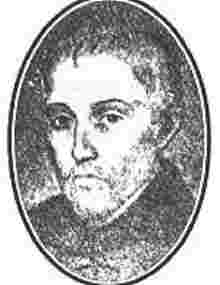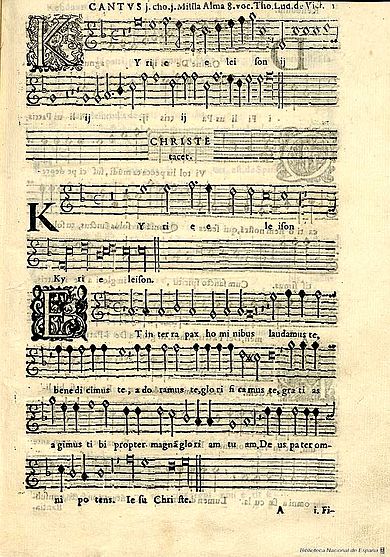Tomás Luis de Victoria facts for kids
Tomás Luis de Victoria (born around 1548, died August 20–27, 1611) was Spain's most famous composer during the Renaissance period. He is considered one of the most important composers of his time, alongside Giovanni Pierluigi da Palestrina and Orlande de Lassus. People especially admired his intense and emotional motets and his music for special church services like the Offices for the Dead and Holy Week.
Unlike many other composers, almost all of Victoria's surviving music is church music. It is also polyphonic, meaning it has many independent voice parts singing together, and is set to Latin texts. Victoria was a Catholic priest, a talented organist, and a singer. He worked in both Spain and Italy, but he preferred composing music over performing it.
Contents
Life and Career
Tomás Luis de Victoria was born in Sanchidrián, a town in the province of Ávila, Castile, Spain, around 1548. He passed away in 1611.
Victoria was the seventh of nine children. His father died in 1557, and his uncle, Juan Luis, became his guardian. As a boy, Victoria was a choirboy at Ávila Cathedral. Records show that his uncle proudly presented Victoria's first book of music to the church, reminding them that Victoria grew up there. Because he was such a skilled organist, many believe he started learning the keyboard at a young age in Ávila. He likely also studied "the classics" at St. Giles's, a boys' school in Ávila, which was highly praised.
Studying in Rome
In 1565, King Philip II gave Victoria a special grant, allowing him to travel to Rome, Italy. There, he became a singer, also known as a cantor, at the German College. This college was founded by St. Ignatius of Loyola. It is thought that Victoria might have studied with the famous composer Palestrina around this time, and he was certainly influenced by Palestrina's musical style.
From 1573, Victoria held two jobs: one at the German College and another at the Pontifical Roman Seminary. He worked as a chapelmaster (the person in charge of music) and taught plainsong (a simple type of church music). In 1571, he started earning a steady income as a teacher at the German College. When Palestrina left the Seminary, Victoria took over his role as maestro.
In 1574, Victoria became a priest. Church leaders often asked for his advice when choosing people for important music jobs in cathedrals because he was so famous and knowledgeable. He was also a dedicated organist at a convent, even after he became well-known as a performer. However, he did not stay in Italy forever.
Return to Spain
In 1587, King Philip II allowed Victoria to return to his home country, Spain. Philip made him a chaplain to his sister, Empress María. She was living in retirement with her daughter at the Monasterio de las Descalzas de St. Clara in Madrid.
Victoria worked at the Descalzas Reales convent for 24 years. For 17 of those years, he served as chaplain to the Empress until she passed away. After her death, he became the convent's organist. Victoria was paid very well at the Descalzas Reales, earning more than he would have as a cathedral chapelmaster. He received money every year from 1587 until 1611.
When Empress Maria died in 1603, she left money for three chaplain positions in the convent, and one of them went to Victoria. He said he never took extra pay for being a chapelmaster and preferred to be the organist. People respected him so much that his contract allowed him to travel often. He visited Rome for two years starting in 1593 and even attended Palestrina's funeral in 1594. Victoria died in 1611 in the chaplain's home and was buried at the convent. His exact burial place is still unknown.
Music
Victoria is the most important composer of the Counter-Reformation in Spain. He is also one of the most respected composers of sacred music from the late Renaissance period. He focused only on church music.
Victoria's music showed his personality, expressing the deep passion of Spanish religious feeling. People like Padre Martini praised Victoria for his beautiful melodies and joyful ideas. His works have become popular again in the 20th century, with many new recordings. Many listeners feel that his music has a special, intense, and direct emotional feeling. Some believe this quality is not as strong in Palestrina's music, which is often calmer in rhythm and harmony. There are differences in how they wrote music, for example, in how they handled melodies and certain musical sounds called dissonances.
Victoria was very skilled at making different choirs sing together, sometimes overlapping and dividing their parts. He also wrote complex parts for voices, and the organ often played a very important role, almost like a solo instrument, in his choral pieces. While he didn't invent the idea of writing psalms or antiphons for two choirs, he certainly made this style more popular. Victoria often republished his earlier works, making changes and improvements each time.
He published his first book of motets in 1572. In 1585, he wrote his Officium Hebdomadae Sanctae. This was a collection of 37 pieces for the Holy Week celebrations in the Catholic Church, including the eighteen motets of the Tenebrae Responsories.
Victoria admired two composers, Giovanni Maria Nanino and Luca Marenzio, for their work in madrigals (secular vocal music) rather than church music. It is also thought that Victoria might have taken lessons from Escobedo when he was young, before moving to Rome.
Victoria said that he wrote his most creative works while under the support of Otto, Cardinal von Truchsess. However, some historians believe he learned about music from other sources too. When Victoria was working for Philip II of Spain, he sometimes felt tired from all his composing. Many of the pieces he wrote for important figures like Cardinal Michele Bonelli, King Philip II, or Pope Gregory XIII were not paid for properly.
In terms of style, Victoria's music avoids the very complex counterpoint that many other composers of his time used. He preferred simpler melodies and homophonic textures, where all parts move together. However, he still created rhythmic variety and sometimes included strong and surprising contrasts. His melodies and use of dissonance were freer than Palestrina's. Sometimes he used musical intervals that were usually not allowed in the strict rules of 16th-century counterpoint, like ascending major sixths. He even used occasional diminished fourths, for example, in a sad passage in his motet Sancta Maria, succurre miseris.
Victoria sometimes used dramatic "word-painting." This is when the music tries to show the meaning of the words, a technique usually found in madrigals (secular songs). Some of his sacred music used instruments, which was common in Spanish church music of that time. He also wrote polychoral works, which means music for more than one group of singers placed in different parts of a space. This was a style popular with composers of the Venetian school who worked at St. Mark's Basilica in Venice.
His most famous work, and his masterpiece, is Officium Defunctorum. This is a Requiem Mass (a special mass for the dead) written for the Empress Maria.
Works
The number of voices for each piece is shown in parentheses.
Masses
- Alma redemptoris mater (8 voices)
- Ascendens Christus (5 voices)
- Ave maris stella (4 voices)
- O magnum mysterium (4 voices)
- O quam gloriosum (4 voices)
- Pro defunctis (4 voices)
- Pro defunctis (6 voices)
- Pro Victoria (9 voices)
Motets
Victoria wrote many motets, which are short sacred vocal pieces.
- O magnum mysterium (4 voices)
- O quam gloriosum est regnum (4 voices)
- O vos omnes (4 voices)
- Sancta Maria, succurre miseris (4 voices)
- Ascendens Christus in altum (5 voices)
- Dum complerentur dies Pentecostes (5 voices)
- Ave Maria (8 voices)
Hymns
Victoria composed many hymns, which are songs of praise. Most are for 4 voices, except for Tantum ergo (5 voices).
- Ave maris stella
- Christe redemptor omnium
- Lucis creator optime
- Pange lingua
- Tantum ergo sacramentum
- Veni creator spiritus
Lamentations
These pieces are based on the biblical book of Lamentations, often sung during Holy Week.
- Incipit lamentation Jeremiae (4 voices)
- Ego vir videns (5 voices)
- Misericordiae Domini (4 voices)
Passions
Victoria also composed settings of the Passion, which tells the story of Jesus's crucifixion.
- St. Matthew Passion
- St. John Passion
Tenebrae Responsories
This is a collection of 18 motets for the Holy Week services called Tenebrae.
- Amicus meus
- O vos omnes
- Ecce quomodo moritur Justus
Selected Recordings
Here are some recordings of Tomás Luis de Victoria's music. All the texts are in Latin and come from Catholic church services.
- Victoria, Tenebrae Responsories. Pro Cantione Antiqua: Deutsche Harmonia Mundi CD GD77056
- Victoria, Officium Defunctorum. Musica Ficta, Raúl Mallavibarrena: Enchiriadis CD EN 2006
- Victoria, Sacred Works. Ensemble Plus Ultra: DGG Archiv CD DDD 0289 477 9747 0 AM 10
- Victoria, Tenebrae Responsories. The Tallis Scholars: GIMELL. CDGIM 022
- Victoria, Lamentations of Jeremiah. The Tallis Scholars: GIMELL. CDGIM 043
Images for kids
See also
 In Spanish: Tomás Luis de Victoria para niños
In Spanish: Tomás Luis de Victoria para niños





